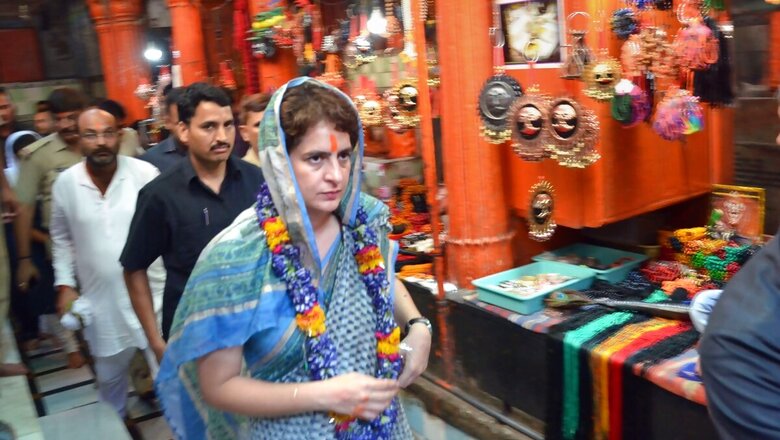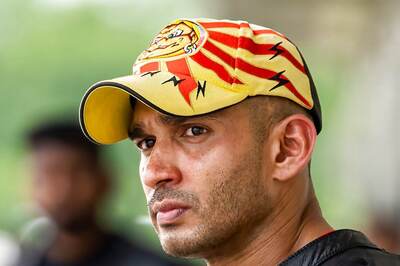
views
After refraining from commenting politically on the groundbreaking ceremony of the Ram temple, the Congress is attempting a course correction on Ayodhya. The party has fielded none other general secretary Priyanka Gandhi to signal this clear shift as she heralded the ceremony as a symbol of national unity, fraternity and cultural congregation.
“Simplicity, courage, restraint, sacrifice, commitment, are the essence of the name Deenbandhu Lord Rama. Ram is in everyone, Ram is with everyone. With the message and blessings of Lord Ram and Mother Sita, the Bhoomipujan of Ramlalla's temple became an occasion for national unity, fraternity and cultural congregation,” she tweeted.
For someone, who posited herself as opposed to BJP’s majoritarian politics and criticised the ruling establishment for the perceived communal agenda, the tweet was certainly unexpected.
Call it a reset, call it the exigencies of realpolitik or call it whatever you want, but Priyanka Gandhi’s statement is a throwback to her father Rajiv Gandhi’s attempt to play the ‘Hindu card’ in the mid and late 80s that ultimately paved the way for the meteoric rise of the BJP.
The tweet may have left many, including some Congress workers, who had put their faith on Congress to maintain its ideology against the onslaught of the Hindu right, but the Gandhi scion and the person in charge of the Congress in Uttar Pradesh has hardly charted a new political course.
She looks to be sticking to the path Rajiv Gandhi had taken to balance out his pandering to the fundamental sections within the Muslim community post the Shah Bano verdict.
The Supreme Court had delivered a landmark judgment where it granted a maintenance allowance to Shah Bano, a divorced Muslim woman, under the CrPC. The case became a political hot potato as the court regretted that ‘uniform civil code’ had remained a dead letter. As the prime minister, Rajiv Gandhi hurriedly brought in Muslim Women’s (Protection of Rights on Divorce) Act, 1986 to override the apex court’s judgment. This was done as he felt losing support of the minorities.
But what he didn’t expect was a counter-mobilisation from the Hindu right. The BJP saw its biggest opportunity of branding the Congress as a pseudo-secular party, with pseudo-secularism becoming the buzzword word as it would dominate the political discourse for the next several years.
During this same period, the BJP decided to throw its hat into the VHP-led Ramjanmabhoomi movement. Meanwhile, Arun Nehru, Rajiv Gandhi’s trusted advisor also saw it as an opportunity to pacify the aggrieved Hindus and nip in the bud BJP’s political machinations to become a major force.
Uttar Pradesh, at that time, was under Congress rule. In 1986, Rajiv Gandhi along with Arun Nehru persuaded the then chief minister, Bir Bahadur Singh, to open the locks of the ‘structure’ and even allowed religious ceremonies to take place inside the premises.
But contrary to their expectations, the Congress and particularly Rajiv Gandhi started losing the plot as the issue and agenda was hijacked by VHP-BJP. This had as much to do with Rajiv Gandhi’s political naivety and inability to read the situation as it had to do with VHP-BJP viewing it as a stepping stone to their ultimate goal of constructing the Ram temple.
For the prime minister things got worse as in course of time VP Singh raised the banner of rebellion over Bofors which hurtled the Congress towards becoming a disarrayed force.
But the opening of gates was not the only decision that Rajiv Gandhi had taken in relation to the Ram Janmabhoomi movement. In 1989, Rajiv’s government did accede to VHP’s demand of Shilanyas. The Shilanyas took place just days before the 1989 Lok Sabha polls. In fact, N D Tiwari, the chief minister of the state at that time, later recalled that Rajiv Gandhi’s home minister, Buta Singh, had taken the prime minister to visit Devraha Baba, a Hindu seer with considerable following. The seer had indirectly requested the PM to allow Shilanyas to take place to which he acquiesced.
The decision suited a politically cornered Rajiv Gandhi who was facing an uphill challenge through multiple fronts. While the corruption charges of Bofors had been his political undoing, the Mandal-Kamandal politics of BJP and the Janata Dal was eating into Congress’ tradition caste coalition in UP and Bihar.
To make matters worse, the continuous tirade of VP Singh was slowly chipping away at Rajiv Gandhi’s personal political capital. He was left with no agenda to fall back upon except for ‘Hindu votes’ to save the situation. Leaving no stone unturned, Rajiv Gandhi even launched his 1989 political campaign from Faizabad, the district headquarters of Ayodhya, promising a ‘Ram Rajya’. However, all this while he kept on assuring the Muslim minorities that Babri Masjid will be protected.
The results of the election proved to be ominous for Rajiv Gandhi as BJP trumped Congress in Rajasthan, Madhya Pradesh & Gujarat whereas UP and Bihar voted for the Janata Dal. The Congress only managed to get three seats in UP and four seats in Bihar. In the other Hindi heartland states, it got eight seats in Madhya Pradesh, while in Rajasthan it failed to open its account.
Rahul Gandhi also belatedly decided to jump into the occasion as he tweeted invoking the qualities of love, justice and fellow feeling to be an essential ingredient of Lord Ram – the deity. While Priyanka Gandhi’s statement was made with an eye on the assembly polls in UP, slated to be held in 2022, Rahul Gandhi’s soft pedalling of Hindutva is a sign of political necessities. But he hasn’t extolled the Bhumi Pujan, not yet.
That leaves the door open for him to be a Shiv Bhakt as he did before the assembly polls in Rajasthan, Madhya Pradesh and Chhattisgarh in 2019 or he can choose to position himself against ‘Hindutva terrorism’ if the situation dictates.
When it comes to what Kamal Nath and Digvijaya Singh are doing, it is no different to what certain Congress leaders like Arun Nehru and Buta Singh did at in the 80s with their public support to the temple movement.
But, the Congress has comfortably forgotten a big lesson from the late 80s and 90s – the party’s downfall began when it tried to balance catering to both the Hindu and Muslim political forces.

















Comments
0 comment